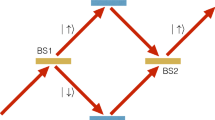Abstract
Recently a new attempt to go beyond QM was performed in the form of so-called prequantum classical statistical field theory (PCSFT). In this approach quantum systems are described by classical random fields, e.g., the electron field or the neutron field. Averages of quantum observables arise as approximations of averages of classical variables (functionals of “prequantum fields”) with respect to fluctuations of fields. For classical variables given by quadratic functionals of fields, quantum and prequantum averages simply coincide. In this paper we generalize PCSFT to the composite quantum system. The main discovery is that, opposite to a rather common opinion, a composite system can be described by the Cartesian product of state spaces (like in classical physics) and not by the tensor product of them (like in conventional QM). A natural interpretation of the quantum pure state for a composite system is proposed: it is the nondiagonal block in the covariance matrix of the random field describing a composite system. The interpretation of a pure state due to Dirac and von Neumann seems to be an artifact of the conventional mathematical description of micro-systems. PCSFT provides a new possibility for interpretation of entanglement.
Similar content being viewed by others
References
Khrennikov, A. (ed.): Foundations of Probability and Physics. Series PQ-QP: Quantum Probability and White Noise Analysis, vol. 13. WSP, Singapore (2001)
Adenier, G., Khrennikov, A., Nieuwenhuizen, Th.M. (eds.): Quantum Theory: Reconsideration of Foundations-3. American Institute of Physics, Ser. Conference Proceedings, vol. 810. Melville (2006)
Plotnitsky, A.: Reading Bohr: Physics and Philosophy. Springer, Berlin (2006)
Bohr, N.: Phys. Rev. 48, 696–702 (1933)
Einstein, A.: The Collected Papers of Albert Einstein. Princeton University Press, Princeton (1993)
Einstein, A., Infeld, L.: Evolution of Physics: The Growth of Ideas from Early Concepts to Relativity and Quanta. Simon and Schuster, New York (1961)
Einstein, A., Podolsky, B., Rosen, N.: Phys. Rev. 47, 777–780 (1935)
Khrennikov, A.: In: Roychoudhuri, C., Kracklauer, A.F., Creath, K. (eds.) The Nature of Light: What Are Photons? Proceedings of SPIE, vol. 6664, pp. 666409-1–666409-9. SPIE, San-Diego (2007)
Khrennikov, A.: J. Phys. A, Math. Gen. 38, 9051–9073 (2005)
Khrennikov, A.: Phys. Lett. A 357, 171–176 (2006)
Khrennikov, A.: Phys. Lett. A 372, 6588–6592 (2008)
De la Pena, L., Cetto, A.M.: The Quantum Dice: An Introduction to Stochastic Electrodynamics. Kluwer, Dordrecht (1996)
Nieuwenhuizen, Th.M.: In: Adenier, G., Khrennikov, A., Nieuwenhuizen, Th.M. (eds.) Quantum Theory: Reconsideration of Foundations-3. American Institute of Physics, Ser. Conference Proceedings, vol. 810, pp. 198–210. Melville (2006)
Boyer, T.H.: In: Barut, A.O. (ed.) Foundations of Radiation Theory and Quantum Electrodynamics, pp. 141–162. Plenum, New York (1980)
Scully, M.O., Zubairy, M.S.: Quantum Optics. Cambridge University Press, Cambridge (1997)
Mandel, L., Wolf, E.: Optical Coherence and Quantum Optics. Cambridge University Press, Cambridge (1995)
Nelson, E.: Quantum Fluctuations. Princeton University Press, Princeton (1985)
Davidson, M.: J. Math. Phys. 20, 1865–1870 (1979)
Davidson, M.: In: Adenier, G., Fuchs, C., Khrennikov, A. (eds.) Foundations of Probability and Physics-4. American Institute of Physics, Ser. Conference Proceedings, vol. 889, pp. 106–119. Melville (2007)
‘t Hooft, G.: Quantum mechanics and determinism. hep-th/0105105 (2001)
’t Hooft, G.: The free-will postulate in quantum mechanics. quant-ph/0701097 (2007)
Elze, T.: The attractor and the quantum states. arXiv:0806.3408 (2008)
Ballentine, L.E.: Rev. Mod. Phys. 42, 358–381 (1970)
Von Neumann, J.: Mathematical Foundations of Quantum Mechanics. Princeton University Press, Princeton (1955)
Schrödinger, E.: Proc. Am. Philos. Soc. 124, 323–38 (1980)
Author information
Authors and Affiliations
Corresponding author
Rights and permissions
About this article
Cite this article
Khrennikov, A. Description of Composite Quantum Systems by Means of Classical Random Fields. Found Phys 40, 1051–1064 (2010). https://doi.org/10.1007/s10701-009-9392-8
Received:
Accepted:
Published:
Issue Date:
DOI: https://doi.org/10.1007/s10701-009-9392-8



